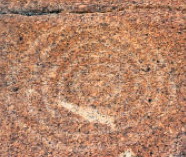
The U.S. Forest Service gives talks at 6:30 PM Saturdays during the summer.
Park at the China Wall parking area around the bend 1/4 mi. from the bridge.

Petroglyphs Of The Northern Sierra Nevada, California,
by Daniel G. Foster,
Senior State Archaeologist,
California Department of Forestry and Fire Protection (CAL-FIRE),
March 12, 1999
In 1966, Louis A Payen completed a comprehensive inventory and analysis of prehistoric rock art in California’s northern Sierra Nevada. This outstanding study identified 133 rock art sites, classified into two major groupings or traditions, Pit-Groove and Abstract-Representational. The two groups were further subdivided into seven separate categories or styles - each defined by a group of attributes and associations.
Style 7 (High Sierra Abstract-Representational) (Donner Pass - Site CA-NEV-5) These are distinctive petroglyph panels on bedrock surfaces in the higher elevations of the northern Sierra Nevada. Style 7 rock art panels are more complex and contain a greater variety of design elements than any other prehistoric rock art style in the northern Sierra Nevada region, and although considerable variation exists in design elements, there is also an underlying rigidity. Common designs include concentric circles, simple circles elaborated by line elements, wavy lines of varying complexity, tracks, and anthropomorphic-zoomorphic representations. Payen defined Style 7 rock art using a sample of 13 sites, and described it as the most distinctive style of the seven. He suggested that the track element may be diagnostic for Style 7, occurring at 11 of his 15 sites.
The majority of Style 7 petroglyph elements are abstract, consisting of circles, wavy lines, zigzags, and arrangements of these elements into complex designs. We analyzed two of the more naturalistic and readily recognizable petroglyph elements, the bear track, and the anthropomorph (human stick figures).
Evidence (location and chipped-stone lithics [tools] found nearby) supports the hypothesis of an association between these sites and the Martis Archaeological Complex. This evidence is fairly pervasive and argues for the placement of this style of rock art firmly within the Middle Archaic time period, from 4,000 to 1,500 B.P. which has been equated with the Martis Complex.
Links:
Petroglyphs Of The Northern Sierra Nevada, California by Daniel G. Foster,
Senior State Archaeologist,
California Department of Forestry and Fire Protection (CAL-FIRE),
March 12, 1999
Ancient Petroglyph Makers Of The Northern Sierra at Friends of Sierra Rock Art (FSRA)
Books - Papers:
Ancient Rock Carvings of the Central Sierra: The north Fork Indian Petroglyphs, 1984, Willis A Gortner
Prehistoric Rock Art of California, 1978, Heizer and Clewlow
"Four Rock Art Studies", 1978, Ed. C. William Clewlow Jr.
Other: